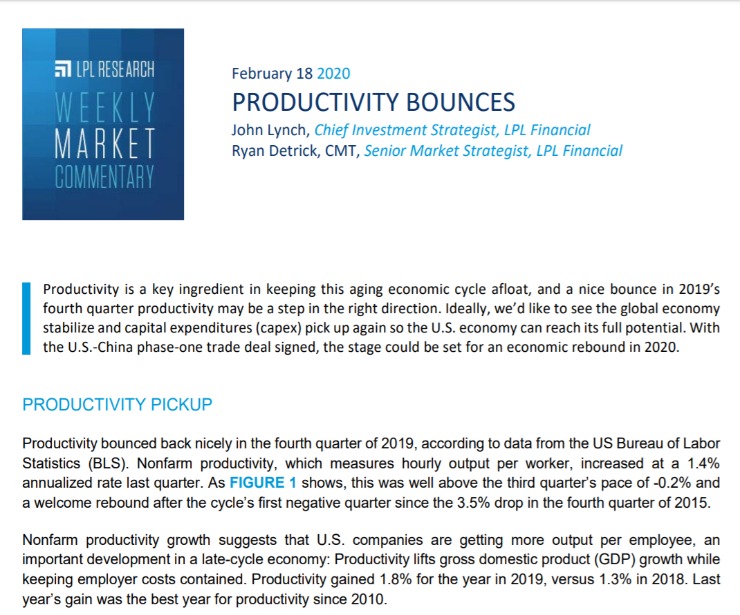Productivity is a key ingredient in keeping this aging economic cycle afloat, and a nice bounce in 2019’s fourth quarter productivity may be a step in the right direction. Ideally, we’d like to see the global economy stabilize and capital expenditures (capex) pick up again so the U.S. economy can reach its full potential. With the U.S.-China phase-one trade deal signed, the stage could be set for an economic rebound in 2020.
PRODUCTIVITY PICKUP
Productivity bounced back nicely in the fourth quarter of 2019, according to data from the US Bureau of Labor Statistics (BLS). Nonfarm productivity, which measures hourly output per worker, increased at a 1.4% annualized rate last quarter. As FIGURE 1 shows, this was well above the third quarter’s pace of -0.2% and a welcome rebound after the cycle’s first negative quarter since the 3.5% drop in the fourth quarter of 2015.
Nonfarm productivity growth suggests that U.S. companies are getting more output per employee, an important development in a late-cycle economy: Productivity lifts gross domestic product (GDP) growth while keeping employer costs contained. Productivity gained 1.8% for the year in 2019, versus 1.3% in 2018. Last year’s gain was the best year for productivity since 2010.

WHY PRODUCTIVITY IS IMPORTANT
Higher productivity is a powerful tool, as it can boost both consumer and corporate well-being. Productivity increases typically have come as businesses invested in capital improvements and employee training, which is why growth in capex is a key part of our economic outlook.
Growing productivity also may help offset rising labor expenses, as companies get more output per dollar spent, which can help mitigate inflationary pressures and support healthy profit margins for U.S. companies.
Increased business spending is the primary catalyst for higher productivity, as better equipment and training boost output per worker, although a tightening labor market has also helped. Labor shortages and accelerating wage growth normally have motivated companies to invest in boosting output with current labor. In turn, workers may get paid more as output increases, which could flow through to higher consumer spending.
After seeing solid growth in productivity the first two quarters of 2019, a substantial slowdown occurred in the third quarter as the U.S.-China trade dispute weighed on global growth and disrupted global supply chains. U.S. businesses have largely shelved investment in the face of elevated uncertainty, as nonresidential investment has dropped for the past three quarters for the first time since early 2016.
The U.S.-China phase-one trade deal could be a positive for business investment, as it removes a major uncertainty and could motivate some businesses to resume expansion plans in 2020 and beyond.
The Organisation of Economic Co-operation and Development (OECD) U.S. Composite Leading Indicator (CLI) made a fresh eight-month high in December, up for the fourth consecutive month, suggesting the broad economic rebound from late 2019 had staying power early in 2020. Various global leading indicators have turned higher, with the most significant likely being a recent upgraded outlook for the key German economy.
Additionally, small business optimism has remained near historic highs, and a recent Gallup Poll revealed that the number of Americans who said they are better off today than a year ago hit its highest level since 1999. Optimism plays an important role in economic activity—as long as optimism persists, the odds of a recession could remain fairly low.
Last, corporate America delivered better-than-expected earnings results for the fourth quarter and had good things to say regarding their 2020 outlooks. In fact, S&P 500 Index earnings growth is tracking to a nearly 1% year-over-year increase, up from the nearly 3% decline analysts expected before earnings season started (source: FactSet). Given that strong earnings help to fund capex, which in turn drives productivity, this record long economic expansion could potentially last longer than many think.
WEEKLY MARKET PERFORMANCE REPORT
Please see our new Weekly Market Performance report with insights on major asset classes.
Click here to download a PDF of this report.
IMPORTANT DISCLOSURES
This material is for general information only and is not intended to provide specific advice or recommendations for any individual. There is no assurance that the views or strategies discussed are suitable for all investors or will yield positive outcomes. Investing involves risks including possible loss of principal. Any economic forecasts set forth may not develop as predicted and are subject to change.
References to markets, asset classes, and sectors are generally regarding the corresponding market index. Indexes are unmanaged statistical composites and cannot be invested into directly. Index performance is not indicative of the performance of any investment and do not reflect fees, expenses, or sales charges. All performance referenced is historical and is no guarantee of future results.
All information is believed to be from reliable sources; however LPL Financial makes no representation as to its completeness or accuracy.
This research material has been prepared by LPL Financial LLC.
Securities and advisory services offered through LPL Financial (LPL), a registered investment advisor and broker-dealer (member FINRA/SIPC). Insurance products are offered through LPL or its licensed affiliates. To the extent you are receiving investment advice from a separately registered independent investment advisor that is not an LPL affiliate, please note LPL makes no representation with respect to such entity.
If your advisor is located at a bank or credit union, please note that the bank/credit union is not registered as a broker-dealer or investment advisor. Registered representatives of LPL may also be employees of the bank/credit union. These products and services are being offered through LPL or its affiliates, which are separate entities from, and not affiliates of, the bank/credit union. Securities and insurance offered through LPL or its affiliates are:
Not Insured by FDIC/NCUA or Any Other Government Agency | Not Bank/Credit Union Guaranteed | Not Bank/Credit Union Deposits or Obligations | May Lose Value
Tracking # 1-951291 (Exp. 02/21)
